B00AQUQDQO EBOK Read online
Page 5
Perhaps you know of her case. No? Conveniently lost or forgotten, I suppose. Those millennia were harsh times indeed.
Her studies were suppressed, and she herself forced to enter a Cryptum that turned out to be defective, perhaps sabotaged. A thousand years after she entered, her Cryptum was opened, her death discovered, and her remains quietly disposed of by a small group of former students.
There is an odd story that for tens of thousands of years after her death, Haruspis kept finding her suppressed information floating to the fore in Domain studies. The Domain was favoring her, some claimed—but those tales are now considered legendary.
Still, I have always wondered.
A century before the Didact entered his Cryptum, I found a hard copy of Boundless’s studies preserved in the collection of a former Theoretical on Keth Sidon. Reading this copy, I was curious as to how all the odd facts Boundless had compiled about Path Kethona seemed to fit into a hypothesis emerging from my studies of human genetics.
Humans very likely originated on Erde-Tyrene. But they long ago abandoned that world and moved outward, setting up population centers around two other suns dozens of light-years away, then stringing outposts across almost thirty thousand light-years, out toward the margin of our galaxy.
Forerunners were aware of humans, of course, and tracked their growing populations, their predatory colonial habits. At that time, our boundaries did not merge. Humans were likely to be very troublesome, many thought—but not then. Not yet.
In just a few centuries those human outposts became very populous indeed and would later, during the following conflicts, absorb the brunt of early attacks by the Flood.
But who else had been aware of humans long before the Flood—of humans and perhaps also of Forerunners?
* * *
Keeper approached me and said, in a low voice, “We are on the lookout for neural physics architecture, true?”
“True enough.”
“We’re assuming that Precursors also reached out this far.”
“Assume nothing,” I said. “But search … yes.”
We now made six closely spaced jumps of a few light-years apiece. At the last jump, Audacity opened a small portal from which we might later choose, at will, a wide conical selection of future jumps.
In case we needed to depart Path Kethona quickly.
For many hours, we drifted in and out of the shock wave of our chosen star’s plume of ionized plasma, waving and furling over ten billion kilometers like an immense candle flame dancing in a soft breeze, as it intersected the more diffuse but steady output of a local cluster of suns.
“Four rocky planets,” Keeper announced. The small crew showed little outward excitement. Young and self-impressed, I thought, but still keeping taut discipline.
“And five anomalous masses,” Dawn added, pointing them out in virtual perspective.
“You theorized these masses existed before the sensors reported them,” I said. “How?”
“Slight deviations in the starfield. Very slight.”
“And perturbations in the orbits of two planets,” Keeper said, nodding in admiration at his crewmate’s sensitivity.
“They’re uniform in mass, appear to be uniform in diameter.… Could be failed stars,” Dawn suggested.
“Perhaps,” Keeper said. “But failed stars still release heat, if not visible light. These masses are colder than the interstellar void.”
The quiet that followed was properly respectful. We were thinking the same thoughts. We had seen similar masses before—in our schooling. Only a few still existed in our home galaxy.
“Precursor anchors?” Keeper asked.
“No visible bridges or threads linking them, or out between the stars,” Dawn said. “Not in this system. Not now.”
Even dormant, such constructs were thought to be unstable—perhaps dangerous. Audacity’s ancilla supplied us with records of previous Forerunner encounters. They were not encouraging. Ships vanishing … Surviving crews requiring extensive proto-geometric therapy to return their minds to a proper neural topology.
My crew was unsettled, but undeterred.
“We’ll approach with caution,” I suggested.
Keeper and Dawn linked their armor to mine, and together with Audacity we plotted a fine course across the two billion kilometers that separated us from the closest dark mass.
As a precaution, our armor locked our positions and reduced our chemistry. During the next few days, as our vessel followed a long hyperbolic orbit to the nearest cold, dark mass, we allowed Audacity to refresh our memories on Precursor architecture and all the other mysterious artifacts Forerunners had encountered, some of them billions of years old.
Assuming nothing … and yet knowing, as if by instinct, that we were close to the heart of a controversy that had perplexed Forerunners for hundreds of thousands of years.
Was Path Kethona the source of the Precursors? Or had it been the birth galaxy of another great, more primary race, active even before the Precursors … Or a race before that, on and on back through time to the great Glow itself?
Minds simmering under the tutelage of our ancillas, our bodies moved slow as glass as our ship plunged deeper into the system.
STRING 5
CATALOG
THE JURIDICAL NETWORK briefly opens, and Catalog takes the opportunity to send what it has gathered, then to supplement its understanding of the Librarian’s testimony.
In another system, Juridicals have deposed the Ur-Didact. Catalog is provided selections relevant to the Lifeshaper’s testimony, but she cannot be informed of his survival.
UR-DIDACT
After the capture of my ship in the San’Shyuum quarantine system, the Master Builder locked me into a weapons-grade stasis bubble, like some dangerous bomb.
I have no awareness of the time between.
Then: the deafening peal of a great bell, followed by a smoky ozone stench. The bubble collapsed. All the years of pent-up time rushed in at once and singed my outer skin. That is the way of such bubbles; they are designed to contain and render harmless more than to delicately preserve.
Dropping to the floor in a heap, I wiped a thin layer of ash from around my eyes and tried to estimate, from my weakness, how long I had been in the bubble. My eyes would not focus. My arms and legs trembled. I could barely rise to my feet.
At least a year.
I was aboard a ship—not small, apparently deserted. The bubble had been abandoned in long-term stowage. The compartment had a physical hatch, not locked; lighting dim. Sounds not encouraging: ratcheting, ragged ticking, distant, mournful scraping. An old vessel in poor repair.
Still gathering my wits, I stumbled out of the compartment and down a curving hallway to a transit tube. The tube refused to work. Pressing against the tube’s sides, I twisted and wormed my way to the next open compartment—another stowage area.
Here I found four more military-grade stasis bubbles shoved into a corner. By the thin whine they made, and the flickering view of their contents, I judged they would soon collapse as mine had.
I pulled and shoved the bubbles apart and stood between them on the deck, watching their opacities flow like clouds in a sky. Gradually, I dimly made out a Builder, still wearing armor. The second, possibly a member of Builder Security, without armor—caught halfway between Warrior-Servant physiology and a newer pattern.
The third, in its carapace: Catalog. A Juridical gatherer of information. Of little use in the present circumstance. Juridicals and I have never gotten along. They dogged our every movement in the last phases of the human-Forerunner war.
No sign of the Manipular I had imprinted, nor of the two humans who had accompanied us. Given the Master Builder’s temper and his obsession with fighting the Flood, I suspect they were delivered to one of his research centers and met a bad end.
For the moment, I left the bubbles where they were and made my way to what I assumed was an inboard helm, a compartment ill-lit, bleak, and filthy
with layers of organic debris.
Deserted.
Worse and worse. An unauthorized trading ship or some piece of confiscated junk. At least it was Forerunner. I climbed to the next level, the main bridge.
A restless unease in my gut warned me that gravity on these decks might fail at any moment. Very dangerous—gravity gradients are not to be ignored. I could be slammed up or thrown sideways, smashed to a pulp. As any warrior will tell you, unbalanced gravity is a [TT: expletive, possibly sacrilegious, untranslatable].
I walked around the bridge. The equipment was older than the ships we had fought with at Charum Hakkor. The Master Builder was nothing if not frugal with the way he disposed of his enemies. I wondered where he had found this one—perhaps in some surplus yard on an outlying planet, or a salvage orbit around one of his construction facilities.
I shouted instructions. No response. No ancilla presented itself either to assist or to deny me access.
Pushing aside dust and desiccated scraps of what might have been flesh, I spit onto a clear panel to clear what looked like dried blood. Clearly this vessel had seen desperate action. But what sort?
Through the smeared panel, lights faintly glowed. I swiped the surface again. The lights brightened—then flickered, threatened to go dark. The ship was still functioning—but just barely.
At least the air was not freezing—and still breathable, but dense, stale.
How far had we traveled, for how long, and from where?
To where?
A disquieting thought … That we had been sent on a long journey to no system in particular, moving at less than light speed, without benefit of jump or portal. When the power to the stasis bubbles declined, mine opened—to release me into a limbo of slow decline and death.
Was it possible I had underestimated the moral degeneracy or the raging fury of the Master Builder?
The panel lights glowed brighter. I danced my fingers over the panel and managed to summon a grainy display of what lay forward of the ship: a planetary limb, reddish and angry. I thought I recognized a distinctive swirl of continents, like paint stirred with a stick—a unique tectonic formation. This could be Uthera Midgeerrd, on the extreme outer reaches of the Forerunner ecumene, less than a hundred light-years from the unpatrolled borders of the galactic margin.
Before I entered the Cryptum, Uthera had been regarded as a far-flung outpost of Forerunner culture and design, distinctly anti-Builder in its sympathies, populated by half-renegade Miners and others who had deserted their rates. Perhaps the Master Builder found delicious irony in sending a Promethean to this undisciplined place.
Movement behind me. I turned to see a face peer over the rim of the transit tube. With a slow, cold shock, I recognized a fellow veteran of the human wars, a commander of one of my tactical squadrons—known at the time as Sharp-by-Striking.
“Distinguished company!” he murmured. “Is this the veritable Didact, come to join me in exile?” He pulled himself into the compartment and stretched his arms. He appeared much reduced by hardship—paler, very thin. “There are still two others … Harsh stasis. Doesn’t look good down there.”
We approached each other warily, then crossed arms, caught up in ancient emotions—not all of them pleasant. Sharp had opposed my grand strategy and been instrumental in convincing the Old Council my Shield Worlds were unworkable.
All that, of course, meant nothing now.
He peered at the display. “Is that Uthera?” he asked. “Not encouraging. I’ve served on Flood watch on one hulk after another for almost a century, a thousand light-years and more from here. Now … Uthera! My well-deserved reward for serving Builders. But you! I had heard rumors. Released from your Cryptum…”
“Our situation,” I interrupted, with the gentlest command voice. “Tell me what you know.”
“Well, for one, we’re in a Burn,” he said with an unhappy click.
“I don’t know what that is.”
“No ancillas, no armor…” He examined his hands and curled his fingers as if they were unfamiliar. “Weak as newborns. A Burn is a thema or margin arc lost to the Flood. This entire system is infested. Likely every surrounding system as well, for dozens of light-years.” He dropped his shoulders. “Once you trained me, Didact. I have failed. I am yours to punish as you see fit.”
I have difficulty forgiving those who have brought harm to those I respect and admire. But Sharp-by-Striking was a pitiful shadow of what he had once been.
As for myself—
Little better.
“Looks like we’re stuck with each other,” I said. “You know this hulk and what it’s capable of?”
He drew himself up again and took a deep breath.
“A Builder reject, stockpiled against direct orders to scuttle and send to salvage. It should have been recycled long ago. Instead, it’s been put to use where success was unlikely, to replace newer, far more expensive ships. I’ve served on several. Hard duty, Didact.” He swallowed and grimaced. “Builders are ever driven by power and profit. I did my best to serve the ecumene.”
“No doubt,” I said.
Now Sharp turned his own self-loathing into cold, outward anger, an old tactic among Warriors who had survived defeat. “Someone has to have ordered this one into the Burn, against any sensible plan. If there are other vessels … they might have all been overtaken, commandeered by the Flood, used to spread contagion.” His eyes narrowed and he groaned deep in his chest. “We’re on a plague ship!”
The look of utter horror on his features unsettled my innards even more than the fluctuating gravity. “We don’t know that,” I said.
“The others … Still in stasis. They might be infected!”
“We don’t know that, either.”
“In the early stages of infection … all you might see would be a tiny patch, a blemish, a single tendril!”
He coughed and then doubled up in a spasm. Clearly he had been treated badly before being discarded. The air was getting worse. My own lungs and throat felt tight.
Sharp’s spasm subsided. “My weakness has passed, Didact,” he said. “It is good to serve you again. If you will have me.”
We regarded each other for a somber moment. Sharp-by-Striking in his best days had been a serviceable commander. Something of a talker, however.
“We are where we are,” I said. “Let’s learn what we can.”
He went to the controls and, muttering Warrior curses, pure and sweet to our ears, began to slam and cajole the controls, until the balky old hulk grudgingly did its best to respond. The direct view panels opened and we looked across the full expanse of Uthera.
“Not good,” Sharp said.
Slowly, an old ancilla struggled to revive, appearing first as a spinning disk, then as a headless torso with floating, staring eyes. “Pardon me,” it said. “I am designed to represent the combined intelligence of four vessels. I will respond only to a flotilla commander.”
“A flotilla sub-metarch is common,” Sharp explained in a weary undertone. “None of these ships had the resources to fight alone.”
“None of our other ships are responsive,” the ancilla said. “I am no longer functional. I am merely an incomplete residue—”
“Obviously,” I said. “Never mind that. What can this ship do?”
After an unpleasant interval, during which various portions of the ancilla’s anatomy reappeared, only to disappear again, the residue did its best to diagnose our situation. “We cannot leave the system. This ship cannot formulate a slipspace jump—the necessary components are far too worn, and besides, there is no longer any means to establish a legitimate request.”
“We could ignore protocol,” Sharp muttered.
The fragmented ancilla continued, “There are no local portals. All have apparently been withdrawn. I am only partially aware of this system’s status, but it appears that fifteen nearby suns and their attendant worlds have been quarantined. Perhaps years ago. This much can be recovered from ship’s hi
story.”
“Check on the other two bubbles,” I murmured to Sharp. “Maybe they can tell us something … if they survive release.”
He agreed. Before he entered the transit tube, he looked back at me and said, “I may have some of the attributes of a Builder, but I renounce them. I would like to return to being a Warrior-Servant … in your thoughts, at least.”
“So observed,” I said.
“Thank you, Commander.” He vanished into the tube.
At least we knew where we stood with each other. A better way to die.
I focused my full attention on learning what the ancilla might still be capable of. It was reluctant to test the ship’s scanning capabilities. “I am not attuned to direct control of this vessel,” it said. “Anything I attempt may damage it.”
Uthera seemed unchanged from the last time I had visited this system, but without enhanced sensory input, there was no way I could learn more.
“I’m willing to take that risk,” I said.
“Yes, but I do not have you in memory as an authorized commander.”
“Then locate the commander,” I suggested.
“That will require activating ship’s internal and external sensors. And that may damage our systems. We seem to be at a stalemate.”
Its staring, floating eyes irritated me, so I suggested it revert to the spinning disk or no visual whatsoever. It chose the latter and its responsiveness immediately improved.
“This ship answers a light query. It tells me it no longer remembers its name or number,” it said. “It also informs me an internal report on operability will not damage equipment. That’s a relief, no?”
“Maybe,” I said, paying more attention to the world below, as if staring hard might reveal something I had not noticed to this point.
And it did.
“Ship says external sensors are corroded and barely operable,” the residue continued. “But properly coaxed, they may still supply some information. Shall I coax?”

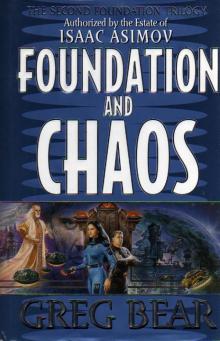 Foundation and Chaos
Foundation and Chaos Halo: Silentium
Halo: Silentium Blood Music
Blood Music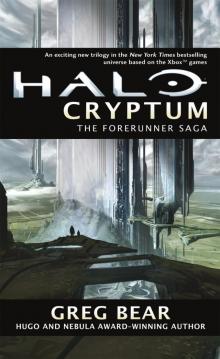 Halo: Cryptum
Halo: Cryptum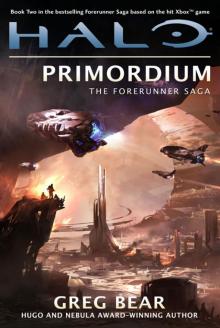 Halo: Primordium
Halo: Primordium The Unfinished Land
The Unfinished Land Hardfought
Hardfought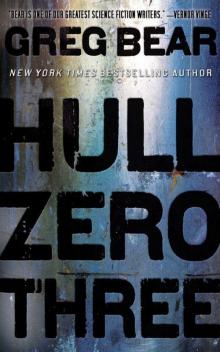 Hull Zero Three
Hull Zero Three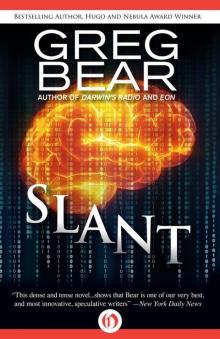 Slant
Slant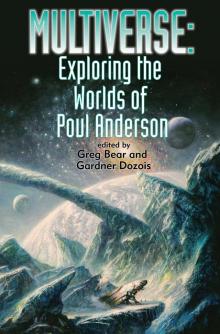 Multiverse: Exploring the Worlds of Poul Anderson
Multiverse: Exploring the Worlds of Poul Anderson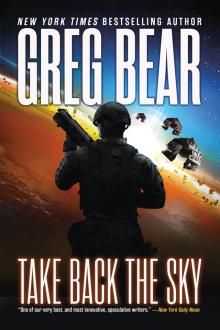 Take Back the Sky
Take Back the Sky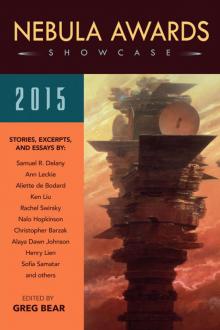 Nebula Awards Showcase 2015
Nebula Awards Showcase 2015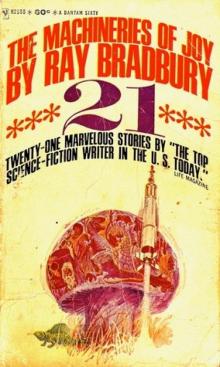 Machineries Of Joy
Machineries Of Joy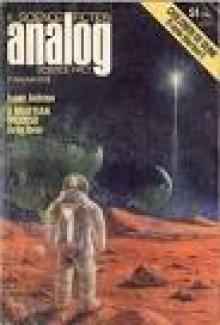 A Martian Ricorso
A Martian Ricorso Eternity
Eternity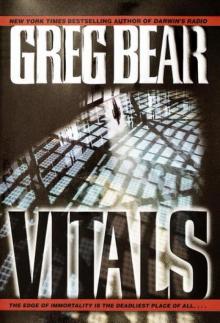 Vitals
Vitals The Infinity Concerto
The Infinity Concerto Beyond the Farthest Suns
Beyond the Farthest Suns Moving Mars
Moving Mars Quantico
Quantico Darwin's Radio
Darwin's Radio Beyond Heaven's River
Beyond Heaven's River Star Wars - Rogue Planet
Star Wars - Rogue Planet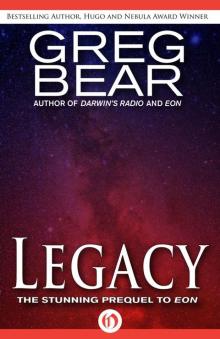 Legacy (Eon, 1)
Legacy (Eon, 1)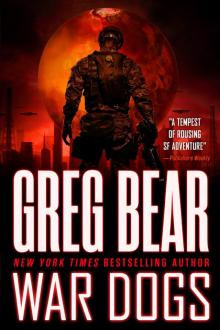 War Dogs: Ares Rising
War Dogs: Ares Rising Sisters
Sisters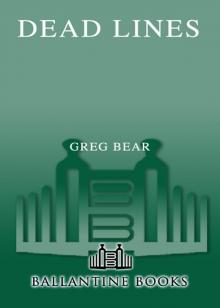 Dead Lines
Dead Lines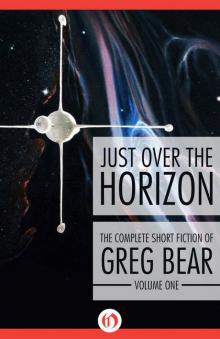 Just Over the Horizon (The Complete Short Fiction of Greg Bear Book 1)
Just Over the Horizon (The Complete Short Fiction of Greg Bear Book 1) Eon (Eon, 2)
Eon (Eon, 2) Venging
Venging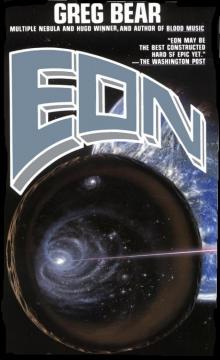 Eon
Eon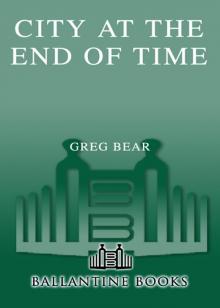 City at the End of Time
City at the End of Time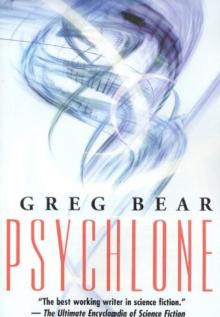 Psychlone
Psychlone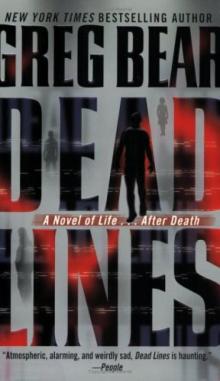 Dead Lines, A Novel of Life... After Death
Dead Lines, A Novel of Life... After Death Eternity (Eon, 3)
Eternity (Eon, 3) Cryptum
Cryptum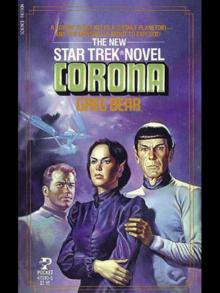 Corona
Corona Sleepside: The Collected Fantasies
Sleepside: The Collected Fantasies Women in Deep Time
Women in Deep Time Queen of Angels
Queen of Angels Darwin's Children
Darwin's Children Dinosaur Summer
Dinosaur Summer The Forge of God tfog-1
The Forge of God tfog-1 Foundation and Chaos f-9
Foundation and Chaos f-9 Star Wars: Rogue Planet
Star Wars: Rogue Planet The Forge of God
The Forge of God Mariposa
Mariposa Halo: Cryptum: Book One of the Forerunner Saga
Halo: Cryptum: Book One of the Forerunner Saga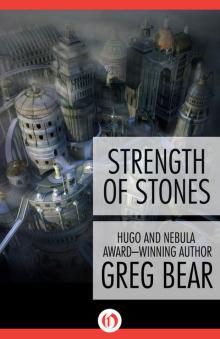 Strength of Stones
Strength of Stones Anvil of Stars
Anvil of Stars B00AQUQDQO EBOK
B00AQUQDQO EBOK Anvil of Stars tfog-2
Anvil of Stars tfog-2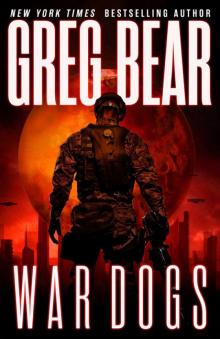 Ares Rising 1: War Dogs
Ares Rising 1: War Dogs Rogue Planet (star wars)
Rogue Planet (star wars) The Machineries of Joy
The Machineries of Joy Far Thoughts and Pale Gods
Far Thoughts and Pale Gods Songs of Earth and Power Omnibus
Songs of Earth and Power Omnibus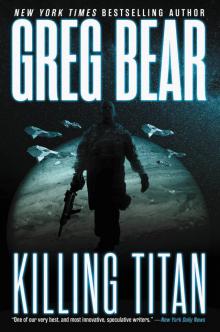 Killing Titan
Killing Titan Darwin's Radio d-1
Darwin's Radio d-1 Darwin's Children d-2
Darwin's Children d-2